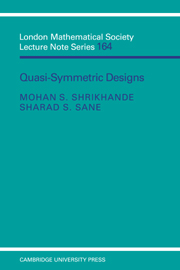Book contents
- Frontmatter
- Contents
- Preface
- Acknowledgments
- I Basic results from designs
- II Strongly regular graphs and partial geometries
- III Basic results on quasi-symmetric designs
- IV Some configurations related to strongly regular graphs and quasi-symmetric designs
- V Strongly regular graphs with strongly regular decompositions
- VI The Witt designs
- VII Extensions of symmetric designs
- VIII Quasi-symmetric 2-designs
- IX Towards a classification of quasi-symmetric 3-designs
- X Codes and quasi-symmetric designs
- References
- Index
I - Basic results from designs
Published online by Cambridge University Press: 05 May 2010
- Frontmatter
- Contents
- Preface
- Acknowledgments
- I Basic results from designs
- II Strongly regular graphs and partial geometries
- III Basic results on quasi-symmetric designs
- IV Some configurations related to strongly regular graphs and quasi-symmetric designs
- V Strongly regular graphs with strongly regular decompositions
- VI The Witt designs
- VII Extensions of symmetric designs
- VIII Quasi-symmetric 2-designs
- IX Towards a classification of quasi-symmetric 3-designs
- X Codes and quasi-symmetric designs
- References
- Index
Summary
In this first chapter, we collect together and review some basic definitions, notation, and results from design theory. All of these are needed later on. Further details or proofs not given here may be found, for example, in Beth, Jungnickel and Lenz, Dembowski, Hall, Hughes and Piper, or Wallis. We mention also the monographs of Cameron and van Lint, Biggs and White, and the very recent one by Tonchev.
Let X = {x1,x2,…,xv} be a finite set of elements called points or treatments and β = { B1,B2,…,Bb} be a finite family of distinct k-subsets of X called blocks. Then the pair D = (X, β) is called a t-(v, k, λ) design if every t-subset of X occurs in exactly λ blocks. The integers v, k, and λ are called the parameters of the t-design D. The family consisting of all k-subsets of X forms a k-(v, k, 1) design which is called a complete design. The trivial design is the v-(v, v, 1) design. In order to exclude these degenerate cases we assume always that v > k >t ≥ 1 and λ ≥ 1. We use the term finite incidence structure to denote a pair (X, β), where X is a finite set and β is a finite family of not necessarily distinct subsets of X. In most of the situations of interest in the later chapters, however, we will have to tighten these restrictions further.
- Type
- Chapter
- Information
- Quasi-symmetric Designs , pp. 1 - 16Publisher: Cambridge University PressPrint publication year: 1991



